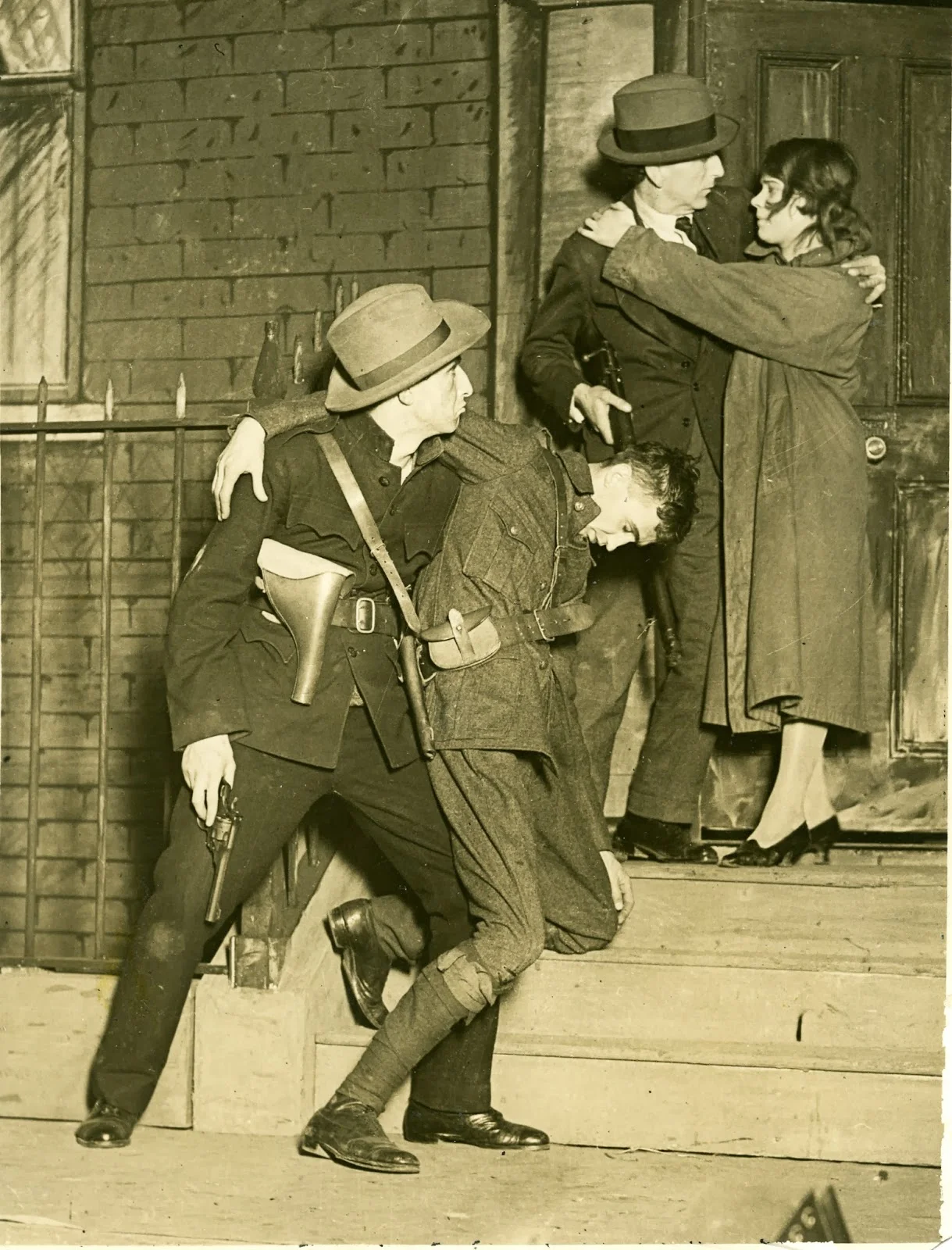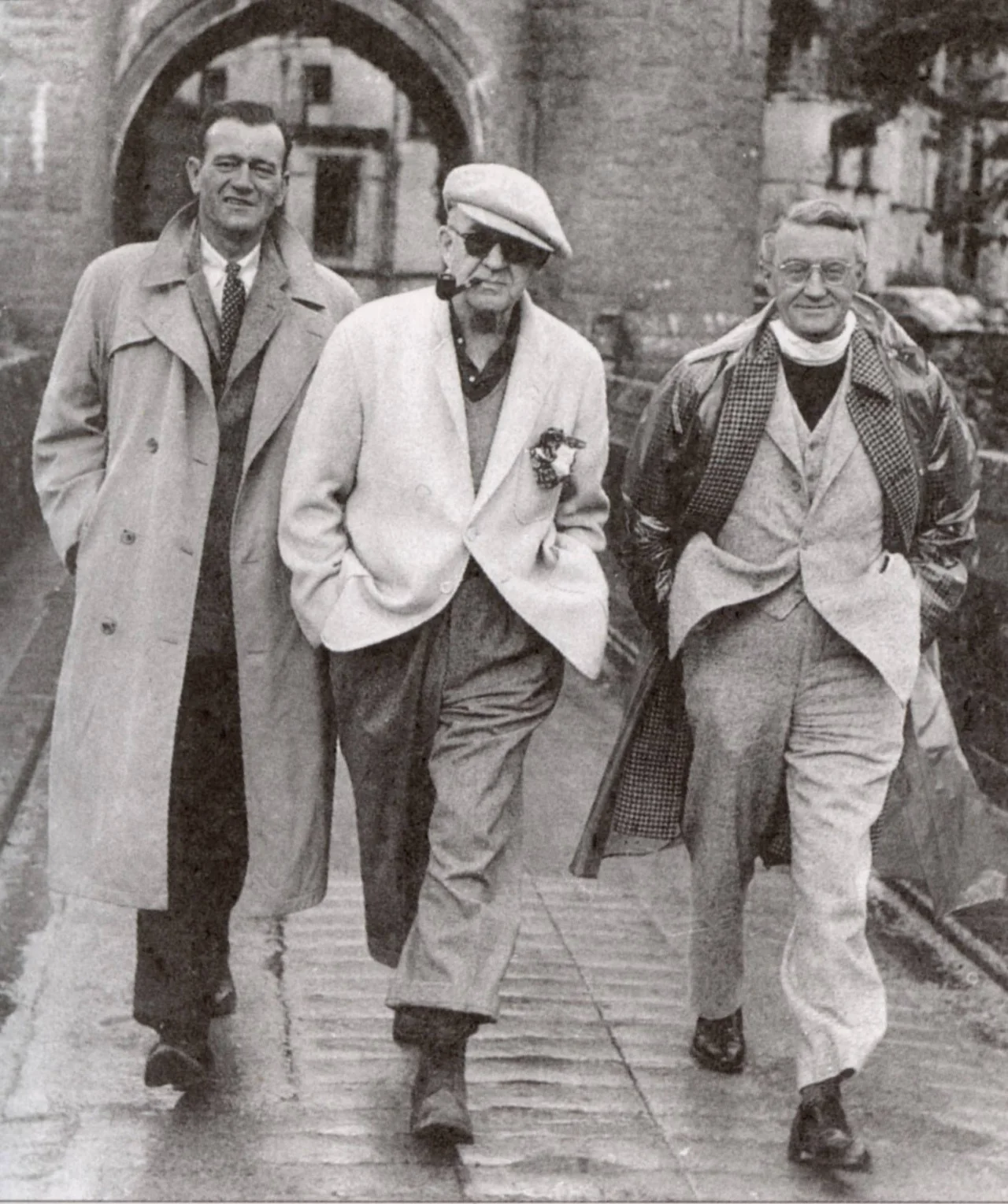Actors Of 1916: Arthur Shields
Arthur Shields (far left) performs in 'The Plough and the Stars', 1926.
While Sean Connolly claimed the unfortunate title of being the first rebel fatality, others were luckier and escaped from Easter Week, 1916 with their lives. For Arthur Shields, his role in the Rising was to become merely an interesting titbit in what was a fascinating career as an actor at home and in the US. Arthur was born into a poor family in Portobello, Dublin in 1896. As one of eight children, his schooling was limited due to the family constantly being forced to move for economic reasons. He began attending acting classes in the Abbey in 1913. Out of this, Arthur secured minor roles in a number of productions, and while the company was on tour in America, he got his first named role.
Arthur signed up to the Volunteers alongside his best friend and future brother in law Charles Saurin in 1914. According to Saurin’s Bureau of Military History Witness Statement, they joined in response to the British shooting of civilians in Bachelors Walk after the Howth Gun Running. The two men were ordered to report to Fairview Park on Easter Monday morning. Arthur having obtained permission from his commanding officer, Captain Frank Henderson, headed into the Abbey Theatre to leave the manuscript of a play that was meant to premiere that day called the “The Spancelled Goat”. From there, Shields reported directly to James Connolly at the GPO instead of returning to Fairview Park.
Shields spent most of the week during the Rising on O’Connell Street, fighting first in the Grand Metropole Hotel, before retreating to an already burning GPO on Friday the 28th of April. His time in the GPO didn’t last long, as the Volunteers quickly retreated again to Moore Street, where Shields met his friend and fellow actor Charles Saurin. The remaining members of the garrison began mouse-holing, knocking holes in the dividing walls of the houses, until eventually they found their way to Hanlon’s Fish Shop at number 20/21 Moore Street.
Share the story here and join the conversation!
Finding themselves in a group of 7 men, Shields and Saurin headed out to the loft at the back of the shop on Moore Lane. Under intense fire, they pressed against the loft walls hoping to spare themselves from the bullets which whizzed above their heads. Not long after they arrived, Padraig Pearse appeared briefly and is described with an air of mysticism by Saurin in his statement. After a couple of hours, a plan was hatched for the remaining members of the garrison to try and make a break for the four courts, where Ned Daly's forces still controlled much of the area. Unfortunately for the men in the loft, their role was to be part of a 'death or glory' squad of 20 to 30 men who were to charge at a British machine gun position at the top of the street, providing a distraction for the others to try and make a break for it.
Clip from John Ford's 1936 production of 'The Plough and the Stars' featuring Arthur Shields as Padraig Pearse. The film also starred Arthur's brother Barry Fitzgerald as trade unionist Fluther Good.
Luckily for the men, the order to charge never came. They waited and waited, until eventually the order for surrender came through. Read aloud by Sean McDermott, the men prepared to step out onto Moore Street. As they marched to the point of surrender at the Gresham Hotel, they passed reminders of the death and destruction that had taken place all week across the city. Henry Street was still in flames as the Volunteers marched passed the waiting British soldiers, pistols in hand. When they reached the Gresham, standing before them was General Lowe waiting for their surrender.
The men spent a full day standing before the Gresham, encircled by the troops of the Royal Irish Regiment. Eventually in fours they were marched off and held in Richmond Barracks. From Richmond, Shields was interned first at Knutsford, Kent and then sent on to Frongoch in Wales. Shield’s was released as part of the first general amnesty in August 1916, and by October he was back on the stage in the Abbey.
It was in 1917 that Arthur Shield’s brother first began to gain attention in the acting world. William Joseph Shields first appeared in a lead role on the Abbey Stage using the stage-name Barry Fitzgerald and would go on to enjoy world fame playing some distinctly Irish parts in Hollywood movies. By 1920, Arthur and Barry were full time actors at the Abbey Theatre, acting in the first productions of all of Sean O’Casey’s famous plays. Arthur appeared in major roles in the first production of the Juno and the ‘Paycock’ and The Plough And the Stars. During the 1930s he toured the US four times with the Abbey, acting as its tour manager. In 1936, both he and his brother were cast in John Ford’s film production of The Plough and the Stars. For Barry, this was his ticket to the limelight and he went on to feature in a number of Hollywood movies. In 1944, he won an Academy Award for his role as Father Fitzgibbon in the film Going My Way.
(L-R) JohnWayne, John Ford and Arthur Shields during a break in filming for 'The Quiet Man', 1951.
Arthur continued to work on stage in Ireland and abroad. He struck up a partnership with Edward Choate in New York and the two of them embarked on a partnership to produce Carroll’s Kindred in Broadway. This was unsuccessful and brought the final blow to his failing first marriage. During the Second World War, Shields was frequently being cast in supporting roles in major Hollywood productions, such as She Wore a Yellow Ribbon and The Quiet Man. It was around this time that Shields split from the Abbey Theatre, it has been said due to the incompatibility of his protestant nationalist views and the increasingly Catholic dominated Ireland. From then on he spent most of his time in the US working in film and television.
By the 1950s, Arthur’s roles in movies were diminishing and he was in failing health. He moved, along with his third wife and daughter, to California where he lived out his remaining years. Unfortunately by 1966, the 50th anniversary of the Rising, Arthur was unable to return home due to ill health. In 1970, he died in California and was finally brought home to Ireland, where he was laid to rest in Deans Grange Cemetery. To fight in 1916 and not have it as the defining moment for which you are widely remembered is quite something, but to do it in the way of Arthur Shields, where it was merely a footnote in his obituary is remarkable.
- Written by Daire Collins




